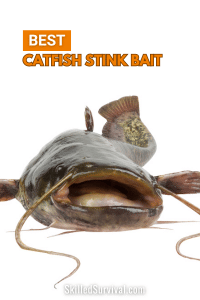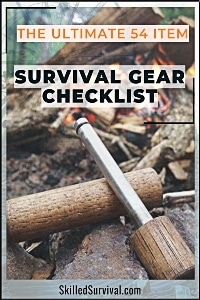
A Complete Guide On Making & Using Homemade Catfish Stink Bait
Because if you learn how to catch fish…you’ll never go hungry!
It’s one of those survival skills that’s enjoyable today but could pay off big time in a crisis.
Plus, it’s a skill you can pass on from generation to generation…
TOPICS IN THIS GUIDE… ↓(click to jump)
- My History With Stink Baits
- Catfish Bait Ingredient List
- Basic Stink Bait Recipe
- Cheese Stink Bait Recipe
- 4 Surprising Catfish Bait Myths

Want a free 54 item survival gear checklist?
Click here to instantly download this Complete Checklist PDF. No purchase necessary.My History With Stink Baits
My father taught me this recipe.
He got it from his dad.
And I’ve been using it ever since to catch some of the best catfish in my area.
The recipe I’m going to share is a sink bait recipe.
Stink bait recipes are ideal because everyone’s favorite fish seems attracted to them.
Making catfish bait typically involves the mixing of several unrelated products.
So, yes, it’s supposed to smell awful.
↓ Catfishing With Homemade Stink Bait | Best Recipe
So, let’s get to it.
Catfish Bait Ingredient List
Here are the things you’ll need to make some catfish bait:
- 1 1/2 c. Livers (Chicken, Deer, Cow, whatever you have)
- 1/4 c. Flour
- 2-3 T. Garlic Salt
- 1 Sardine & 2 T. Sardine Oil (from the can)
- 2 tsp Strawberry Jell-O
- 1 egg
Basic Stink Bait Recipe
You should blend the liver until it becomes a liquid.
Then, empty it into a clean PLASTIC peanut butter jar and add the remaining ingredients.
Stir well until thick.
Cover.
Do NOT open indoors.
You should allow the bait to sit for at least forty-eight hours.
Remember, the rawer, the better.
I love the above recipe for its simplicity, and it does its job of catching plenty of fish.
Cheese Stink Bait Recipe
However, if you prefer a cheese-based sink bait, I would suggest this next one:
↓ How To Make Stink Bait For Catfish With Cheese
Things you’ll need:
- Mason jar (any old empty jar will do)
- 1lb of cheese spread. (The type doesn’t matter, but the cheaper, the better, right?)
- 8 oz. of beef blood
- 1 container of minced garlic
- Sawdust
- Sponge
- Popsicle stick
- An out-of-the-way place allows it to ripen
Allow the cheese to warm up for a few minutes in the sun.
Mix the cheese, blood, and garlic into the jar and stir until it’s evenly dispersed and there are no big chunks.
Add some sawdust to thicken the paste you have just made.
Add a small amount at a time.
It’s important to avoid big clumps.
You want to add enough sawdust to make it tacky, like the look of good oatmeal.
Once you have the right consistency, seal the cap on the jar and set it out in an area with plenty of sunlight.
Ideally, you want to allow it to sit for a minimum of a week, but the longer, the better.
Some of the biggest catfish I ever caught involved bait that had sat in the sun for three months.
So there, you have it.
With the way the world is now, I’ve found that having a skill like this becomes increasingly valuable every day.
Making catfish bait might not be something you can put on your resume, but it’s in no way a skill that won’t come in handy.
Set your alarm, have that boat ready, and enjoy the lake’s peacefulness in the early morning.
That is until the fish start biting.
Because they don’t stand a chance now that you know how to make catfish bait.
4 Surprising Catfish Bait Myths Worth Knowing
Myth #1: “Stinkier is Better”
Ah, the age-old misconception that catfish are irresistibly drawn to the foulest odors known to humanity.
While it’s true that catfish have a highly developed sense of smell, it doesn’t mean you should subject yourself to handling putrid concoctions that would make a skunk squirm.
Catfish aren’t always attracted to the nastiest stench; they’re more interested in the natural scents of their usual prey, such as smaller fish and insects.
Myth #2: “Prepared Baits Guarantee Success”
While prepared baits can yield results, they’re not a one-size-fits-all solution.
Catfish can be finicky eaters, and what works like a charm one day might leave you empty-handed the next.
Myth #3: “Bigger Baits Catch Bigger Catfish”
Sure, the idea of hooking a massive catfish using a monstrous bait is enticing.
However, size isn’t the sole determining factor here.
Catfish have an exceptional ability to sense vibrations in the water, which means they can detect even the tiniest of morsels.
So, don’t be afraid to experiment with various bait sizes to see what these whiskered creatures are really craving.
Myth #4: “Only Live Bait Will Do”
Live bait has undeniable merits, but it’s not the be-all and end-all of catfish enticement.
Cut bait, dough balls, and even artificial lures can elicit equally enthusiastic bites.
Catfish are opportunistic feeders, and their taste preferences can vary based on their environment and conditions.
A Bit Of Catfish Bait History
Back in the day, our angling ancestors used simple, readily available baits to lure in catfish.
Worms and insects, such as crickets, were among the early favorites.
These baits were easy to come by and mimicked the natural diet of catfish, making them a logical choice for bait.
As time passed, anglers began experimenting with other baits, including cheese, bread, and even bits of soap.
These unconventional options were born out of necessity and ingenuity as folks sought to make the most of what they had.
One of the most intriguing developments in the world of catfish bait has been the rise of stink baits.
These pungent concoctions, often made from a blend of fermented ingredients like cheese, blood, and various secret spices, have gained a dedicated following among catfish enthusiasts.
The theory behind these odorous baits is simple yet effective: catfish, with their keen sense of smell, are drawn to the foul scent, leading to more bites and bigger catches.
Today, modern catfish bait options continue to evolve.
Commercial baits offer convenience and consistency, while traditionalists still swear by tried-and-true homemade concoctions.
Whether you’re a seasoned catfish angler or just getting started, understanding the rich history of catfish bait is essential for mastering the art of landing these whiskered giants.
So, whether you choose to go old-school with worms or embrace the stinkbait revolution, remember that the pursuit of catfish is not just a sport; it’s a journey through angling history.
P.s. Do You Live In A 'Danger Zone' County?

Find out now using my Danger Zone County List & Special Report it’s absolutely FREE.
In minutes you’ll know EXACTLY where you stand and if you should be worried or not..
So click here to get my FREE Danger Zone County List & Report…

Recommended Reading
Survival Pack: How To Build One NOW (before SHTF)
Survival pack list From Scratch. Packs That Will Make You A Hero To Your Family. Plus, Some Of Th Best Packs You Can Buy
Best Survival Packing List To Plan For An Evacuation
Everyone needs a survival packing list to organize their escape. That way you won't regret leaving something critical behind.
13 Best Wild Edibles ANYONE Can Find Nearly Everywhere…
Discover the best wild edible plants you can find and eat nearly anywere. Knowing and identifying these wild edibles could save your life.
Paracord Projects: 17 Survival Devices You Can Make
I share the best paracord projects that are both fun and useful. By doing these crafts you'll always have lifesaving cordage on hand.
Best Survival Skills Every Adventurer Should Learn
The best survival skills will keep you alive even in extreme conditions. 1. Water 2. Shelters 3. Fire 4. Navigation 5. Signaling 6. Medical 7. Foraging...
Cold Weather Survival: Unexpected Ways To Stay Warm
In a cold weather emergency, you can be a cold weather survivor or a victim. These critical skills will help you stay warm & alive.